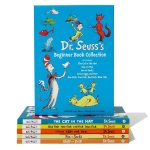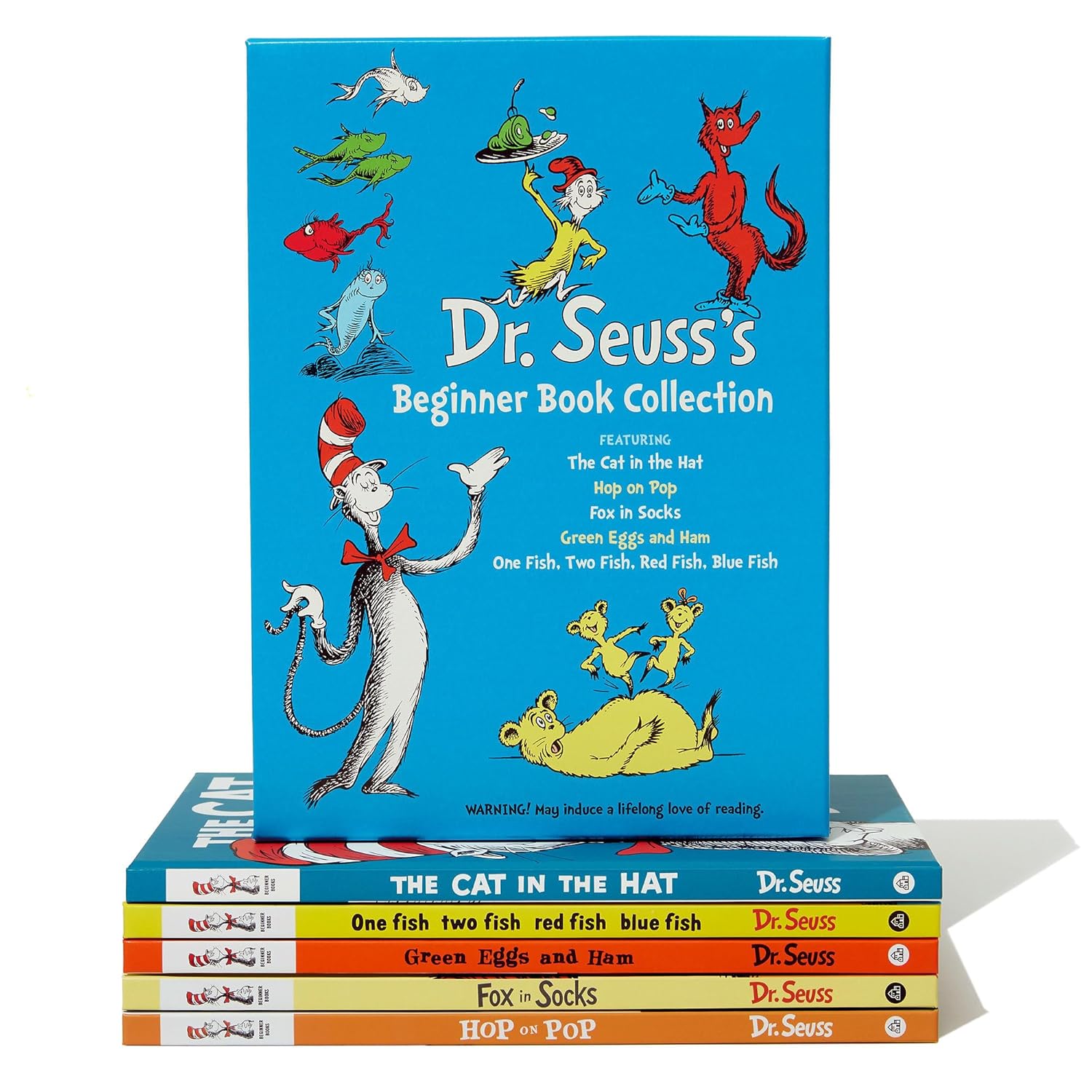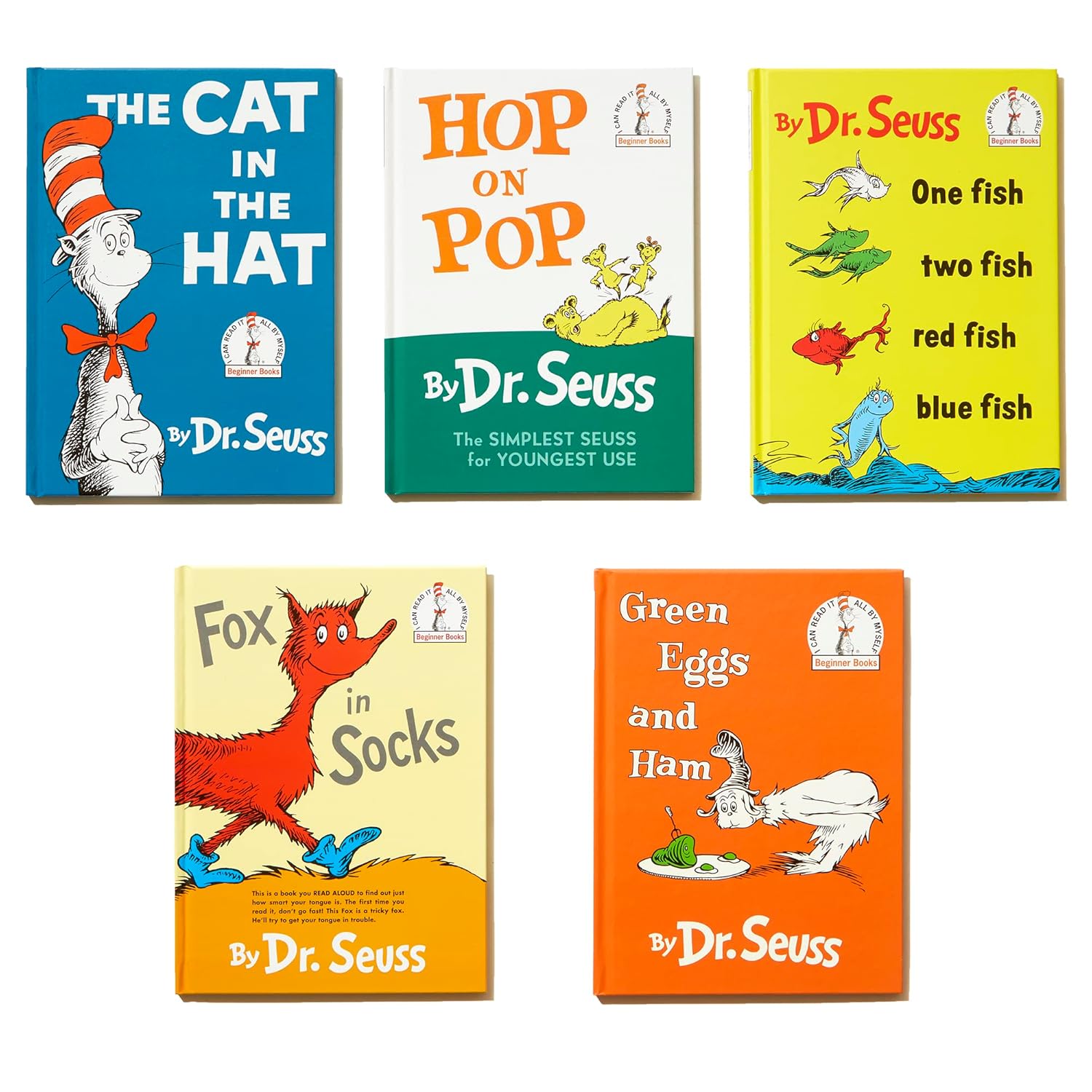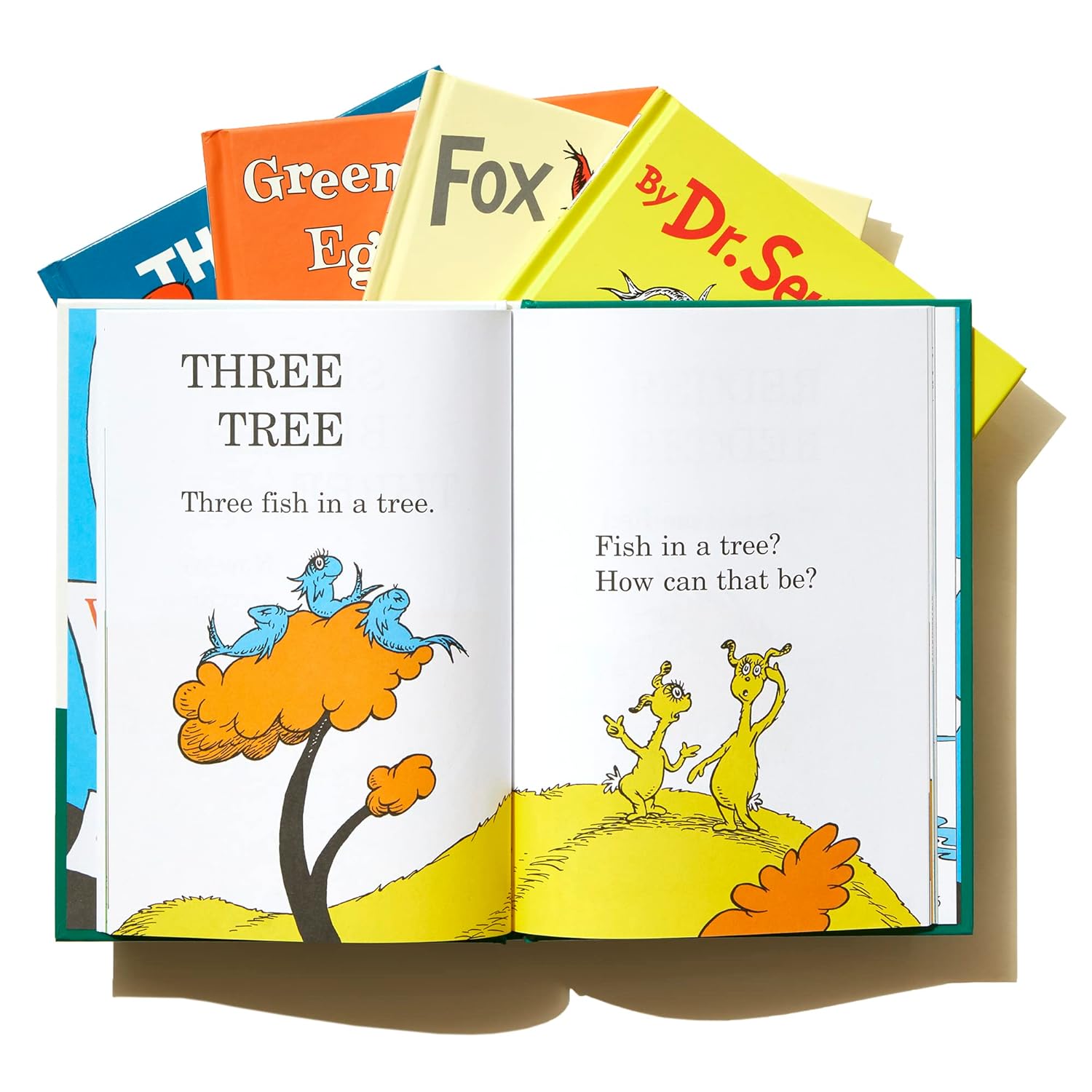
Dr. Seuss’s Beginner Book Boxed Set Review green eggs and ham Reading Guide – Oemiu
Dr. Seuss’s Beginner Book Boxed Set: A Gateway to Reading and Beyond
Imagine a world painted in vibrant hues, where nonsensical creatures roam, and language dances with a playful rhythm. This is the world Dr. Seuss opens up for young readers. The Dr. Seuss’s Beginner Book Boxed Set is more than just a collection of stories; it’s a carefully curated stepping stone to literacy, designed to ignite a lifelong love of reading. Specifically, let’s dive into the cultural phenomenon that is “Green Eggs and Ham,” and how it functions as a masterful teaching tool. These books aren’t simply about entertainment; they’re about introducing phonics, expanding vocabulary, and fostering comprehension in an engaging and accessible way. The Beginner Book series prioritizes simplicity, featuring limited vocabularies and repetitive sentence structures, enabling children to build confidence as they decode words and understand the narratives. This confidence is crucial; it’s the bedrock upon which future reading success is built. The boxed set provides a treasure trove of these confidence-boosting stories, allowing children to explore different themes and characters, all while reinforcing essential reading skills. The illustrations, distinctive and full of whimsical details, further enhance the learning experience, capturing children’s imaginations and making the act of reading a joyful adventure. Let’s face it: kids love zany, and Seuss delivers it by the truckload. The enduring popularity of these books is a testament to their effectiveness and their timeless appeal.
Unpacking the Magic: What Makes Dr. Seuss’s Beginner Books So Effective?
The genius of Dr. Seuss lies in his ability to combine educational principles with sheer entertainment value. His Beginner Books are carefully crafted to align with the principles of emergent literacy, focusing on phonemic awareness, phonics, vocabulary, and comprehension. The use of rhyming and repetitive patterns helps children predict words and recognize sounds, making the decoding process less daunting and more intuitive. Consider the simple yet powerful structure of “Green Eggs and Ham.” The constant refusal, followed by the increasing persistence of Sam-I-Am, creates a predictable pattern that children can easily follow. This predictability provides a sense of mastery, encouraging them to continue reading and building their reading stamina. The limited vocabulary, consisting of common sight words and easily decodable words, further supports their efforts. More than just simplicity, the vocabulary is selected to be useful and frequently encountered in other texts, making the transition to more complex reading material smoother. The books also subtly introduce grammatical concepts, such as sentence structure and verb conjugation, without overwhelming young learners. The illustrations play a critical role in supporting comprehension. The visual cues provided by the illustrations help children understand the meaning of the words and sentences, even if they are not yet able to decode them independently. This multimodal approach to learning – combining text and images – caters to different learning styles and enhances retention. Many parents report using the illustrations to encourage conversations about the story, further enriching the reading experience and promoting language development. The impact extends beyond reading skills; these books also foster creativity, imagination, and a love of language.
A Closer Look at “Green Eggs and Ham”: More Than Just a Mealtime Mishap
“Green Eggs and Ham,” arguably the most iconic of the Beginner Books, is a masterpiece of linguistic simplicity and narrative ingenuity. The story revolves around Sam-I-Am’s relentless attempts to convince the unnamed protagonist to try a plate of green eggs and ham. Despite repeated refusals and a litany of locations where the protagonist would *not* eat this peculiar dish, Sam-I-Am persists, showcasing an unwavering optimism and salesmanship that is both humorous and slightly unnerving. The book’s charm lies in its absurdity and its repetitive structure, which makes it incredibly engaging for young readers. The simple vocabulary – consisting of only 50 different words – is meticulously chosen to be easily decodable and memorable. This allows children to focus on the meaning of the story and to build their reading fluency. The repetition of phrases like “I do not like them, Sam-I-Am” reinforces word recognition and helps children internalize sentence patterns.
But “Green Eggs and Ham” is more than just a lesson in phonics and vocabulary; it’s also a subtle exploration of themes such as open-mindedness, perseverance, and the importance of trying new things. The protagonist’s initial resistance to the green eggs and ham mirrors the reluctance many children feel when faced with unfamiliar foods or experiences. Sam-I-Am’s persistence, while arguably bordering on harassment, ultimately pays off when the protagonist finally relents and tries the dish. To his surprise, he discovers that he actually enjoys it. This revelation underscores the idea that judging things before trying them can lead to missed opportunities. This simple narrative carries a powerful message about challenging preconceived notions and embracing new experiences. While the book is primarily designed for young children, its underlying themes resonate with readers of all ages. It is a reminder that even the most seemingly unappetizing things can be surprisingly enjoyable, provided we are willing to give them a chance. Teaching moments abound when reading “Green Eggs and Ham” with a child, including discussions about trying new foods, being open to different ideas, and the importance of not judging a book by its cover (or a plate of food by its color).
Using the Beginner Book Boxed Set to Enhance Early Literacy Skills
The Dr. Seuss’s Beginner Book Boxed Set provides a wealth of opportunities to enhance early literacy skills. Parents and educators can use these books in a variety of ways to support children’s reading development. One effective strategy is to engage in shared reading, where an adult reads aloud to a child, pausing to discuss the story, ask questions, and encourage prediction. This interactive approach helps children develop comprehension skills, expand their vocabulary, and build a love of reading. Parents can also encourage children to read the books independently, providing support and guidance as needed. The repetitive nature of the stories and the simple vocabulary make them ideal for beginning readers. As children gain confidence, they can progress to reading the books aloud, which helps improve their fluency and pronunciation. Furthermore, the books can be used to teach specific phonics skills. For example, the repetitive use of rhyming words in “Green Eggs and Ham” provides an excellent opportunity to teach children about rhyme and how it can help them decode words.
Here’s a sample activity breakdown:
1. **Pre-Reading Discussion:** Before reading “Green Eggs and Ham,” ask children about their favorite foods and whether they have ever tried something new that they initially didn’t want to.
2. **Shared Reading:** Read the story aloud, emphasizing the rhyming words and the repetitive phrases.
3. **Post-Reading Discussion:** Discuss the story’s themes and ask children what they learned from it. Encourage them to share their own experiences of trying new things.
4. **Phonics Activity:** Focus on the rhyming words in the story, such as “ham” and “Sam,” or “house” and “mouse.” Ask children to think of other words that rhyme with these words.
5. **Creative Writing Activity:** Encourage children to write their own versions of the story, using different foods or locations. For example, they could write a story about “Blueberries and Cheese” or “Apples and Trees.”
The possibilities are endless. The key is to make learning fun and engaging, and to tailor the activities to the child’s individual needs and interests. The beauty of the Beginner Books is that they can be adapted to suit a wide range of learning styles and abilities.
| Book Feature | Benefit for Young Readers |
|---|---|
| Limited Vocabulary | Reduces cognitive overload, builds confidence. |
| Repetitive Sentence Structures | Reinforces word recognition, improves fluency. |
| Rhyming Patterns | Enhances phonemic awareness, aids in decoding. |
| Whimsical Illustrations | Captures attention, supports comprehension. |
| Engaging Storylines | Motivates children to read, fosters a love of books. |
Beyond the Book: Activities and Extensions Inspired by the Beginner Book Boxed Set
The Dr. Seuss’s Beginner Book Boxed Set can serve as a springboard for a wide range of activities and extensions that go beyond the pages of the books themselves. These activities can help children develop their creativity, problem-solving skills, and social-emotional intelligence. One popular activity is to host a Dr. Seuss-themed party, complete with costumes, games, and, of course, green eggs and ham! Children can dress up as their favorite characters, participate in Seuss-themed trivia games, and decorate green eggs using food coloring and edible glitter. Another fun activity is to create a diorama based on one of the stories. Children can use cardboard boxes, construction paper, and other materials to build a three-dimensional representation of a scene from the book. This activity encourages creativity and spatial reasoning. The themes presented in “Green Eggs and Ham” can also be used to spark conversations about trying new things and being open to different perspectives. Parents and educators can ask children about their own experiences of trying new foods or activities, and encourage them to reflect on how they felt before, during, and after the experience.
* **Cooking Activity:** Prepare green eggs and ham with children, discussing the ingredients and the process of cooking. This activity can help children develop their math skills (measuring ingredients) and their science skills (understanding how heat affects food).
* **Dramatic Play:** Encourage children to act out scenes from the books, using props and costumes. This activity can help children develop their communication skills and their ability to express themselves creatively.
* **Art Project:** Create artwork inspired by the books, using different materials and techniques. For example, children could paint a picture of Sam-I-Am, sculpt a green egg out of clay, or create a collage using images from the books.
* **Field Trip:** Visit a local library or bookstore to explore other Dr. Seuss books and other children’s literature. This activity can help children broaden their reading horizons and discover new authors and illustrators.
These are just a few examples of the many ways in which the Beginner Book Boxed Set can be used to enhance children’s learning and development. The key is to be creative, flexible, and responsive to the child’s individual needs and interests. Remember, the goal is to make learning fun and engaging, and to foster a lifelong love of reading.
Choosing the Right Beginner Book Boxed Set: Factors to Consider
When selecting a Dr. Seuss’s Beginner Book Boxed Set, consider several factors to ensure it aligns with your child’s developmental stage and reading goals. The age range is a primary consideration; most Beginner Book sets are designed for children aged 3-8, but individual books may be more suitable for specific age groups. Check the reading level of the books included in the set. Look for sets that feature a gradual progression in difficulty, starting with simple, repetitive stories and gradually introducing more complex vocabulary and sentence structures. The themes and topics covered in the books are another important consideration. Choose a set that includes books that are relevant to your child’s interests and experiences. For example, if your child is interested in animals, look for a set that includes books about cats, dogs, or other creatures. The overall quality of the set is also important. Look for sets that are well-made, with durable covers and high-quality paper. Check the reviews to see what other parents and educators have to say about the set. Do they find the books engaging and effective? Are the illustrations appealing? Is the set worth the price? When considering “Green Eggs and Ham,” consider its availability as a standalone versus part of a larger set.
| Factor | Description | Considerations |
|---|---|---|
| Age Range | Recommended age range for the set. | Match the age range to your child’s developmental stage. |
| Reading Level | Difficulty level of the books. | Look for a gradual progression in difficulty. |
| Themes and Topics | Subject matter covered in the books. | Choose books that are relevant to your child’s interests. |
| Quality | Durability and construction of the set. | Look for well-made books with high-quality paper. |
| Reviews | Feedback from other parents and educators. | Read reviews to get an idea of the set’s effectiveness and value. |
Another factor to consider is the price of the set. Beginner Book sets can range in price from relatively inexpensive to quite expensive, depending on the number of books included and the overall quality of the set. Set a budget before you start shopping and look for a set that offers good value for the money. Don’t be afraid to shop around and compare prices from different retailers. Also, consider the long-term value of the set. A well-chosen Beginner Book set can provide years of enjoyment and learning for your child, making it a worthwhile investment. Ultimately, the best Beginner Book Boxed Set is the one that your child will enjoy reading and that will help them develop a lifelong love of books.
FAQ: Frequently Asked Questions about Dr. Seuss’s Beginner Books
What age range is appropriate for the Dr. Seuss Beginner Book Boxed Set?
Are some books within the set better suited for younger or older children?
The Dr. Seuss Beginner Book Boxed Set is generally recommended for children aged 3 to 8 years old. However, within the set, some books may be better suited for younger or older children depending on their individual reading levels and interests. Books with simpler vocabulary and repetitive sentence structures, like “Go, Dog. Go!” are often a good starting point for younger children aged 3-5. These books focus on basic concepts and are designed to build early reading confidence. Older children, around 6-8 years old, may enjoy books with more complex narratives and themes, such as “The Sneetches” or “Green Eggs and Ham,” even. Ultimately, the best way to determine if a book is appropriate for a particular child is to read it together and see how they respond. Pay attention to their level of engagement, their ability to understand the story, and their willingness to participate in discussions about the book. Don’t be afraid to adjust your selection based on their individual needs and preferences.
How can I use the “Green Eggs and Ham” book to teach my child about trying new things?
“Green Eggs and Ham” is a fantastic tool for teaching children about the importance of trying new things, even when they seem unappealing at first. You can use the story to spark a conversation about trying new foods, activities, or experiences. Start by asking your child if they have ever felt reluctant to try something new. Share your own experiences and talk about how you overcame your initial hesitation. Then, read “Green Eggs and Ham” together, emphasizing the protagonist’s initial refusal and eventual enjoyment of the green eggs and ham. After reading the story, ask your child what they learned from it. Encourage them to reflect on how the protagonist’s perspective changed after trying the dish. You can then relate the story to real-life situations. For example, if your child is hesitant to try a new vegetable, remind them of the protagonist in “Green Eggs and Ham” and encourage them to give it a chance. Frame it as an adventure, a chance to discover something new and delicious. Remember to be patient and supportive, and avoid pressuring your child to try anything they are not comfortable with.
What are some effective strategies for teaching phonics using Dr. Seuss’s Beginner Books?
Dr. Seuss’s Beginner Books are excellent for teaching phonics due to their rhyming, repetition, and carefully chosen vocabulary. One effective strategy is to focus on the rhyming words in the books. Identify pairs of rhyming words, such as “cat” and “hat,” or “Sam” and “ham” (from “Green Eggs and Ham”), and ask your child to think of other words that rhyme with them. This helps develop phonemic awareness, the ability to recognize and manipulate the individual sounds in words. Another strategy is to focus on specific phonics sounds, such as short vowels or consonant blends. Choose books that feature these sounds prominently and point them out to your child as you read. For example, you could focus on the short “a” sound in words like “cat,” “hat,” and “rat.” You can also use the books to teach blending and segmenting skills. Blending is the ability to combine individual sounds to form a word, while segmenting is the ability to break a word down into its individual sounds. Practice blending by sounding out the individual sounds in a word and then asking your child to say the whole word. Practice segmenting by saying a word and then asking your child to identify each of the individual sounds. Make it fun and engaging by using games, songs, and activities.
How do the illustrations in Dr. Seuss’s Beginner Books contribute to a child’s reading comprehension?
The illustrations in Dr. Seuss’s Beginner Books are an integral part of the reading experience, significantly contributing to a child’s comprehension. They provide visual cues that support the text, helping children understand the meaning of the words and sentences, even if they are not yet able to decode them independently. The whimsical and imaginative nature of the illustrations also captures children’s attention and makes the act of reading more enjoyable. For example, in “Green Eggs and Ham,” the illustrations vividly depict the various locations where Sam-I-Am offers the dish, helping children visualize the story and understand the protagonist’s resistance. The illustrations also help children make connections between the text and their own experiences. For example, if a child is unfamiliar with a particular object or concept, the illustrations can provide a visual representation that helps them understand its meaning. The illustrations also encourage children to ask questions and make predictions about the story. For example, they might wonder why the eggs are green or what will happen next. By using the illustrations as a starting point for discussion, you can further enhance their comprehension skills.
Are Dr. Seuss’s Beginner Books suitable for children with dyslexia or other learning challenges?
Dr. Seuss’s Beginner Books can be beneficial for some children with dyslexia or other learning challenges, but it’s important to consider their individual needs and learning styles. The repetitive sentence structures, limited vocabulary, and strong visual cues can be helpful for children who struggle with decoding and comprehension. The rhyming patterns can also aid in phonemic awareness, a crucial skill for reading. However, the whimsical and sometimes nonsensical nature of the stories can also be challenging for some children, especially those who prefer more straightforward and literal narratives. It’s important to assess the child’s individual strengths and weaknesses and choose books that are appropriate for their reading level and cognitive abilities. Consider breaking down the reading into smaller chunks, focusing on specific phonics skills, and using multisensory techniques, such as tracing the letters or using manipulatives to represent the sounds. Consult with a reading specialist or educator for personalized recommendations and strategies.
How can I encourage my child to read Dr. Seuss’s Beginner Books independently?
Encouraging independent reading with Dr. Seuss’s Beginner Books involves creating a supportive and engaging environment. Start by making the books readily accessible and appealing. Place them in a prominent location where your child can easily see and reach them. Read aloud to your child regularly, using enthusiastic voices and engaging expressions. This will help them develop a love of reading and a desire to explore the books on their own. Choose books that are appropriate for your child’s reading level and interests. Start with books that are easy and enjoyable for them to read, and gradually introduce more challenging books as they gain confidence. Provide support and encouragement as needed, but avoid pressuring them or correcting their mistakes too harshly. Focus on the positive aspects of their reading and celebrate their successes. Make reading a fun and social activity. Read together as a family, visit the library, or join a book club. Set a good example by reading yourself. Children are more likely to read if they see their parents reading.
Where can I find resources and activities related to Dr. Seuss’s Beginner Books?
Numerous resources and activities are available online and in libraries to complement Dr. Seuss’s Beginner Books. Websites like Seussville.com offer games, activities, and printable worksheets based on Dr. Seuss characters and stories. Many educational websites and blogs provide lesson plans, reading guides, and craft ideas related to specific Beginner Books. You can also find a wealth of resources on Pinterest, including templates for activities, costume ideas, and party decorations. Your local library is another excellent resource. Librarians can recommend books that are similar to Dr. Seuss’s Beginner Books and can provide information about reading programs and activities. Many libraries also host Dr. Seuss-themed events, such as story times and craft workshops. Online retailers often have customer reviews that can guide you to different activities that can be done with your kids and friends. Remember to tailor the resources and activities to your child’s individual needs and interests to make learning fun and engaging. “Green Eggs and Ham,” due to its popularity, probably boasts the most resources online.




Price: $49.95 - $26.47
(as of Sep 09, 2025 06:21:41 UTC – Details)




